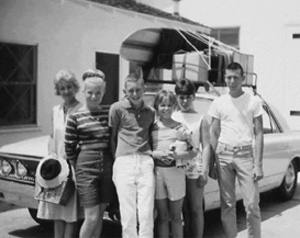My Story post 10
One of my main spots or surf hangouts during my high school days was Hobson Park. Though a little smaller now because of erosion, at least it’s still there. It was there or Stanley’s, just a ¼ mile up from Hobson’s. Stanley’s is long gone.
Hobson’s is a small camp site right on the beach along Pacific Coast Highway about a 10 minute drive up the Rincon from Ventura. And, it happens to be located right at a coble stone reef. At minus tides the reef is dry, a good place for clam digs.
One of the first times I got to go to Hobson’s was with a friend and his family on a camping trip. Drove up there on a Saturday morning got situated in the camp ground did a little clam digging in the afternoon low tide and the guys mom made fresh clam chowder for dinner. Nothin’ like good clam chowder.
On Sunday morning my friend and I got up early to surf. I remember being a little spooked. Not being real familiar with the place, up early, cold weather, over cast and a bit dark. The surf was a much defined peak and the paddle out was a bit more than we expected. Not hard because of the need to push water but longer than imagined from the beach. This also meant that when we reached the line up the sets were much bigger than they looked like from the beach.
There were two other people in the lineup when we got out. Not that good of a surfer yet, I remember sitting there watching the surf go by. Paddling around so as not to get picked off, and too spooked to stroke myself into one of those, what seemed to be, large peeks. What if I didn’t make the drop and fell or couldn’t get a turn off the bottom and wiped out? The beach looked like a long way off, the water cold and dark. A swim for a lost board seemed more of a panic than the surf itself. So I just sat there.
You know… I think that’s why when the surf has a bit of size these days there are plenty kooks in the lineup. No need worry about wipe outs because they’re leashed up to their boards. Anyway, I eventually came in, probably did a shoulder hop or two but that was about it.
Well, I went back to Hobson’s plenty as my high school years progressed. Made up for that first time experience, and then some I’d guess. I’m sure the place has it’s moments but, I don’t remember the surf being that epic there, even if I went there alot. Now Stanley’s…. that’s the spot that could get epic!

I don't know who took this picture of
Stanley's Dinner. But, this site was made into a freeway off ramp. For those that don't know… if you were sitting in that old panel truck and the hood was down, you’d be looking at the Stanley’s line up. Get out of the truck, suit up and grab your board, walk about 100 feet and you’d be at the waters edge. One of the favorite spots of my youth.
D.R.






